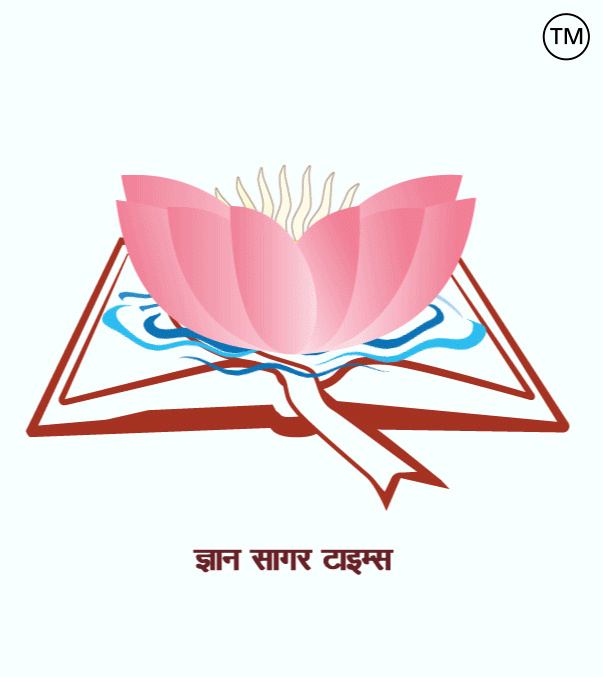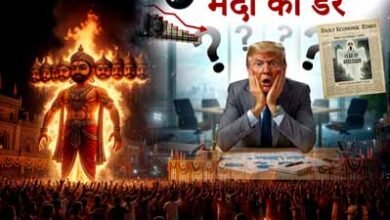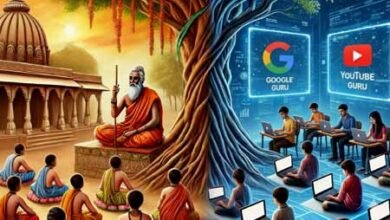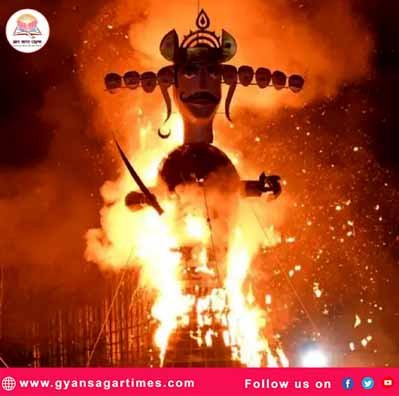
एक गलती की सजा और कितना दोगे?
हर वर्ष दशहरे के दिन पूरा देश बुराई पर अच्छाई की जीत का उत्सव मनाता है. राम की विजय के प्रतीक के रूप में रावण के विशाल पुतले जलाए जाते हैं. यह एक परंपरा बन चुकी है. लेकिन कभी हमने उस पुतले की आँखों में झांककर देखा है? क्या हमने सुना है उसके मन के विलाप को? वह जो पल-पल जलता है और सवाल पूछता है – “क्या मेरी एक गलती मेरी सारी योग्यताओं पर भारी पड़ गई? क्या मैं सिर्फ और सिर्फ एक खलनायक ही था?”
रावण को केवल सीता-हरण जैसे एक अपराध के लिए याद किया जाना, उसके बहुमुखी व्यक्तित्व के साथ अन्याय है. वो एक महान विद्वान, वेद-पुराणों का ज्ञाता और शिव-भक्त था. उसने ‘शिव तांडव स्तोत्र’ की रचना की, जो आज भी शिव-भक्तों द्वारा पढ़ा व गाया जाता है. वह एक कुशल वीणा वादक भी था. क्या एक मूर्ख या केवल दुष्ट व्यक्ति ऐसी रचना कर सकता है? वह लंका का एक अत्यंत शक्तिशाली और सफल राजा था. उसके शासन में लंका “सोने की लंका” कहलाती थी. उसने एक ऐसी समृद्ध सभ्यता का निर्माण किया जिसकी तुलना किसी भी देवलोक से की जा सकती थी.
रावण की सारी योग्यताएं उसके अहंकार (अभिमान) के आगे छोटी पड़ गईं. उसका अहंकार ही उसके पतन का मूल कारण बना. सीता का हरण उस अहंकार की पराकाष्ठा थी, जहाँ उसने स्वयं को धर्म और नैतिकता से ऊपर समझ लिया.
“दोषों के साथ जी रहें फिर भी…”: रावण का सवाल और आज का समाज, रावण का यह सवाल आज के समाज पर एक करारा प्रहार है. हम सब अपने दोषों के साथ जी रहे हैं: क्या हममें से कोई भी पूर्णतः निर्दोष है? हर व्यक्ति में कोई न कोई दोष, कोई न कोई कमजोरी है – क्रोध, लालच, ईर्ष्या, अहंकार. हम इन दोषों के साथ जीते हैं, उन्हें सुधारने का प्रयास करते हैं, और कई बार उन्हें छुपाते भी हैं. फिर केवल रावण को ही क्यों नहीं माफ कर सकते?
हम रावण का पुतला जलाकर बुराई को जलाने का दावा करते हैं, लेकिन क्या वास्तव में ऐसा होता है? क्या अगले दिन से हमारे अंदर का क्रोध, लालच और अहंकार जल जाता है? या फिर यह महज एक रस्म अदायगी बनकर रह गई है? रावण का प्रतीक जलाना आसान है, लेकिन अपने भीतर के रावण को जलाना कठिन. हम एक बाहरी दुश्मन तो खड़ा कर लेते हैं, लेकिन आत्ममंथन से कतराते हैं.
“एक गलती की सजा”: क्या सच में केवल एक ही गलती थी? सीता हरण “एक गलती” नहीं थी, बल्कि एक श्रृंखला की अंतिम कड़ी थी जो उसके चरित्र के मूल दोष को दर्शाती थी. उसने अपनी बहन सूर्पणखा का अपमान होने पर व्यक्तिगत बदले की भावना से सीता का हरण किया. यह एक राजा का नहीं, बल्कि एक घमंडी व्यक्ति का कृत्य था. उसने अपने भाई विभीषण के सत्य और धर्म के मार्ग पर चलने की सलाह को ठुकरा दिया. यह उसकी दूसरी बड़ी गलती थी. उसने श्री राम को एक साधारण मनुष्य समझकर उनका तिरस्कार किया। यह उसकी तीसरी बड़ी भूल थी. इस प्रकार, सीता हरण एक एकल घटना नहीं, बल्कि रावण के अहंकारी और धर्म-विरोधी चरित्र का चरमोत्कर्ष था.
विजयादशमी पर रावण का पुतला जलाना केवल एक ऐतिहासिक घटना की याद दिलाना नहीं है, यह एक प्रतीक है. रावण का दहन वास्तव में हमारे भीतर छिपे उन सभी दोषों का दहन है जो रावण के चरित्र में निहित थे – अहंकार, काम, क्रोध, लोभ और मोह. रावण का यह कथन हमें एक संदेश देता है: “मुझे जलाना आसान है, किंतु मेरे भीतर जो दोष थे, उन्हें पहचानो और उन्हें जलाओ. मैं एक उदाहरण हूँ, ताकि तुम अपने जीवन में वह गलती न दोहराओ जिसने एक महाज्ञानी को भी पतन के गर्त में पहुँचा दिया.”
इसलिए, अगली बार जब रावण का पुतला जले, तो केवल आतिशबाजी और उल्लास न देखें. उस जलते हुए पुतले को एक दर्पण की तरह देखें. अपने भीतर झांकें और प्रश्न करें – “क्या मैं अपने अहंकार, लालच और दुर्भावनाओं को जला पा रहा हूँ? या फिर मैं भी उन्हीं दोषों के साथ जी रहा हूँ और केवल रावण को ही सजा देकर स्वयं को धोखा दे रहा हूँ?”
रावण की सजा अनंत काल तक नहीं दी जा रही, बल्कि हर साल उसकी कहानी दोहराई जा रही है ताकि मानवता एक बार फिर यह सबक सीख सके कि “अहंकार का अंत हमेशा विनाश ही होता है.” यह रावण की सजा नहीं, बल्कि मानव जाति के लिए एक सतत चेतावनी है.
शारदीय नवरात्रि की हार्दिक शुभकामनाएं
========== ========= ===========
How much more punishment will you impose for one mistake?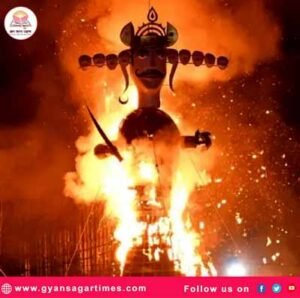
Every year on Dussehra, the entire country celebrates the victory of good over evil. Huge effigies of Ravana are burned to symbolize Rama’s victory. This has become a tradition. But have we ever looked into the eyes of that effigy? Have we heard the lamentations in its heart? It burns every moment, asking the question, “Did one mistake of mine overshadow all my abilities? Was I merely a villain?”
Remembering Ravana solely for a single crime like the abduction of Sita is an injustice to his multifaceted personality. He was a great scholar, a scholar of the Vedas and Puranas, and a devotee of Shiva. He composed the “Shiva Tandava Stotram,” which is still read and sung by Shiva devotees. He was also a skilled veena player. Could a fool or merely an evil person compose such a work? He was an extremely powerful and successful king of Lanka. Under his rule, Lanka was known as “Golden Lanka.” He built a prosperous civilization comparable to any heaven.
All of Ravana’s abilities paled in comparison to his ego (pride). His arrogance became the root cause of his downfall. The abduction of Sita was the culmination of this arrogance, where he considered himself above religion and morality.
“Still living with our flaws…”: Ravana’s question and today’s society. This question from Ravana is a scathing attack on today’s society. We all live with our flaws: is any of us completely innocent? Every person has some flaw, some weakness—anger, greed, jealousy, ego. We live with these flaws, try to correct them, and sometimes even hide them. So why can’t we forgive Ravana alone?
We claim to burn evil by burning Ravana’s effigy, but does that really happen? Do the anger, greed, and ego within us burn away the next day? Or has it become merely a ritual? Burning the symbol of Ravana is easy, but burning the Ravana within us is difficult. We create an external enemy, but shy away from introspection.
“Punishment for one mistake”: Was there really only one mistake? Sita’s abduction was not “one mistake,” but the final link in a series that revealed the fundamental flaw in Ravana’s character. He abducted Sita out of personal revenge after his sister Surpanakha was insulted. This was not the act of a king, but of an arrogant man. He rejected his brother Vibhishana’s advice to follow the path of truth and righteousness. This was his second major mistake. He disregarded Shri Ram, considering him an ordinary human being. This was his third major mistake. Thus, Sita’s abduction was not a single incident, but the culmination of Ravana’s arrogant and anti-religious character.
Burning Ravana’s effigy on Vijayadashami is not merely a reminder of a historical event; it is a symbol. The burning of Ravana is actually the burning of all the vices hidden within us that were inherent in Ravana’s character – ego, lust, anger, greed, and attachment. This statement of Ravana gives us a message: “It is easy to burn me, but recognize the vices within me and burn them. I am an example, so that you do not repeat the mistake in your life that led even a great sage to downfall.”
So, the next time Ravana’s effigy is burned, don’t just watch the fireworks and joy. Look at that burning effigy as a mirror. Look within yourself and ask – “Am I able to burn my ego, greed, and ill will? Or am I also living with those vices and deceiving myself by punishing only Ravana?”
Ravana’s punishment is not being carried out indefinitely, but his story is being repeated every year so that humanity can once again learn the lesson that “arrogance always ends in destruction.” This is not Ravana’s punishment, but a constant warning to mankind.
Happy Sharadiya Navratri.

